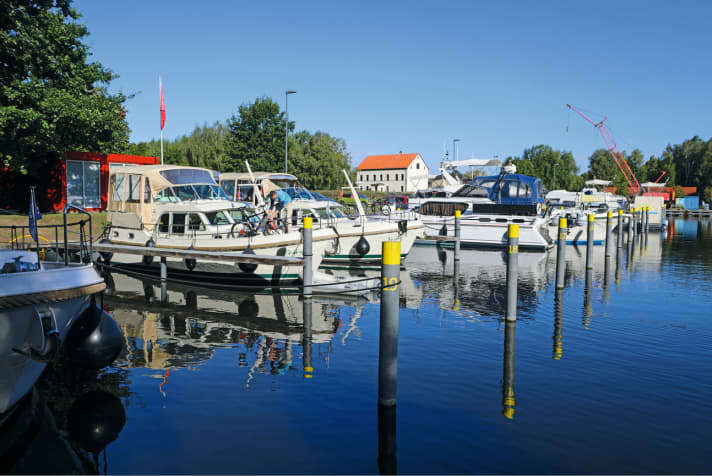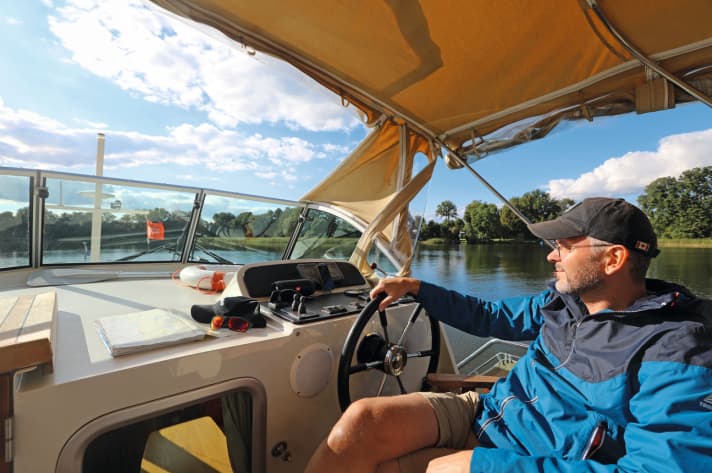



In the midst of nature: on a summer cruise in the north-east - the Upper Havel and Mecklenburg Lake District are some of the most beautiful inland waterways Germany has to offer. Deceleration guaranteed!
Forests, meadows, fields and always water. There is plenty of all this in this vast landscape under its big sky. Here, where Brandenburg merges into Mecklenburg, nature provides the setting for its own panorama - and one of Germany's most remarkable boating areas runs right through the centre of the picture: the Upper Havel.
There aren't that many people here, barely forty on average per square kilometre. In Berlin, which is not too far away, there are four thousand. The bustling population has left its biggest mark on the southern edge of the region - and this is directly related to the nearby metropolis. North of Zehdenick was long a centre of brick production. Berlin was built from the barge, as it is still said today. The material for this has come from here since imperial times: It was extracted from the earth in the clay pits to the left and right of the river, moulded and fired on land and then shipped downstream.
However, production became increasingly unprofitable with the triumph of prefabricated construction, and concrete now set the tone. After reunification, the last fires were extinguished. The furnace was out, forever. The barges also disappeared. The quarries were flooded and turned into ponds and lakes. Today, only the Mildenberg Brickworks Park provides an insight into this bygone era. One of its Hoffmann ring kilns has been preserved as an impressive technical monument and, like the machine hall, can be visited as part of the industrial museum ( www.ziegeleipark.de ).
Our cruise on the Upper Havel starts right next door, almost in the shadow of the chimneys, in the New Harbour of the Brickworks Park. We will be travelling for a week on "Ceres", a Linssen Grand Sturdy 29.9 AC. The comfortable steel displacement yacht is part of the 5 Sterne Yachtcharter fleet, which also operates a base in Berlin-Köpenick. But the big city is not our destination. For us it will be upriver, into nature!
The Uckermark lies ahead of us right at the start. Over a distance of almost thirty kilometres, the Havel winds its way through the solitude in its glacial bed. In deep peace, it makes loop after loop. Beech and oak trees lean over the water and scatter leaves on deck. Alders line the lowlands and pines have taken root on the sandy heights. The red kite circles high above. With this natural course, it is hardly noticeable that we are travelling with our charter yacht on a developed waterway, so invisible are the bank reinforcements behind the reeds and foliage.
But every now and then a lock appears, in fact there are four on the route in question: after the confluence of the Wentow and Templin rivers, the Schorfheide lock is the first. Like the two following barrages in Zaaren and Regow, it is surrounded by greenery. There is no lock keeper for miles around, we are allowed to help ourselves and turn the green bar with the request switch. "Locking accepted", confirms the text display.

In the upper water of the Regow lock, we moor up for a break at the long waiting area, because not only have shaggy goats aroused our curiosity, but also a sign inviting us to the Capriolenhof. It is located right next to the lock and offers various cheese creations made from goat's milk - from Hippie Frisch to Berliner Brikett. All organically produced, of course. We're lucky that today is Sunday, because it's only open at weekends ( www.capriolenhof.de ).
Bredereiche with its lock marks the return to civilisation after three wonderful hours in the countryside. At almost three metres, the lift here is significantly higher than on the first section of the route, where a maximum of 1.20 metres had to be overcome per barrage.
After seven more kilometres, a heavy shower and an even brighter rainbow, the banks finally recede: we have reached Lake Stolpsee, our destination for the day: the jetty of the boathouse in Himmelpfort at its north-eastern corner ( www.stolpsee-bootshaus.de ). If you want to be on the safe side, you can send your wish list to Father Christmas in the summer at the Christmas post office in Klosterstraße next to the medieval monastery ruins. You can also fulfil your wish for a culinary experience right away: At Frosch und Fisch, just five minutes away from the boat, you can enjoy authentic French cuisine ( www.frosch-fisch.de ).
The next day, the first lakes of the Mecklenburg Kleinseenplatte are on the itinerary (even though, strictly speaking, we are still in Brandenburg). The Lychener waters branch off from the Stolpsee at Himmelpfort and head north-east, but we stay on the Upper Havel, pass through the Siggelhavel and pass Fürstenberg on the Schwedtsee. The next two locks in Fürstenberg and Steinhavel cost us a total of almost three hours waiting time - unfortunately no wonder in the peak season.
Lake and river alternate, lined with reeds and forest. Proud dachas can be seen in its shadow. People camp, barbecue and fish. Bathing children wave at the passing houseboats, rafts and canoes. We finally leave Brandenburg at Lake Ziernsee, which is now followed by Lake Ellbogensee, one of the most beautiful in the area. We head for the Priepert marina in the north of the lake. Here, the Upper Havel Waterway continues north towards Wesenberg and, via the Kammerkanal, to Neustrelitz. But we get hold of the last free guest berth and stay ( www.yachthafenpriepert.de ).
To the west is the Müritz-Havel waterway, which we will continue along the next day. We start at the Strasen lock. Here, too, we have to wait an hour. This time, however, we are prepared and use the forced break for a relaxed breakfast. We leave the Müritz-Havel waterway again on Lake Pälitzsee and point the bow towards the Rheinsberg waters to the south. The town of Rheinsberg at the end of the lake is also our destination for the day. The narrow Hüttenkanal first takes us to the Wolfsbruch lock. We are back in Brandenburg and cross Lake Tietzowsee and Lake Schlabornsee before reaching Lake Rheinsberg. This is the entrance to the extensive harbour village of Rheinsberg, which is impossible to miss thanks to its large red and white lighthouse - a real landmark, even if the wooden structure is only there to provide a beautiful view and is not lit. However, we want to go a little further, directly into the town; it is located on the eastern shore of Lake Grienerick, less than two kilometres to the south, and soon afterwards we are moored at one of the jetties of Rheinsberg Marina ( www.schifffahrt-rheinsberg.de ).
The town's tourist highlight is the castle, less than five hundred metres from the harbour. Prussia's Crown Prince Frederick lived here, directly on the lakeshore, before his accession to the throne in 1740, and "Old Fritz" would later say that these were his happiest years. It is therefore not surprising that he instructed his master builder Knobelsdorff to model his design for Sanssouci Palace in Potsdam on Rheinsberg Palace ( www.rheinsberg.de ). The castle park extends to the western shore of the lake. From the obelisk there you have a magnificent view of the city panorama, especially in the evening.

Rheinsberg is the turning point on our trip, and the return journey is initially just as leisurely as the outward journey. The long waiting times at the locks make this possible. Fortunately, we are now really experienced and make a virtue of doing nothing. Deceleration guaranteed!
After an improvised night in Strasen, Fürstenberg is still waiting for us. Guests are welcome at the Fürstenberg yacht club's jetties on Schwedtsee, which is just five minutes away from the market square on the town island. Incidentally, the club also has its own lighthouse. Although it is much smaller than the one in Rheinsberg, it houses a drinks bar - perfect for cooling off after mooring ( www.fbgy.de ). In the evening, we sit next door on the terrace of the Ristorante al Porto and look forward to ending our trip tomorrow as it began - with the most beautiful section of the Upper Havel, but this time in the other direction. The perspective will therefore be different, even if the picture remains the same: the unique nature in the lonely north of the Mark Brandenburg.

